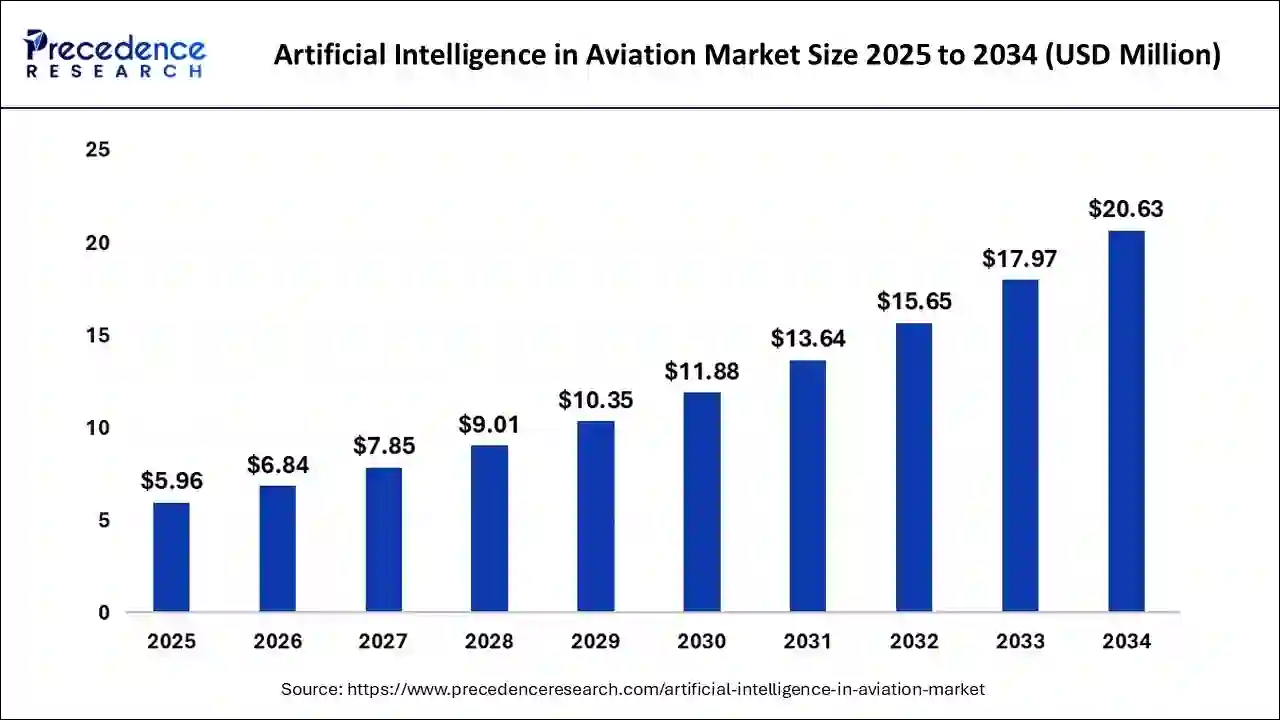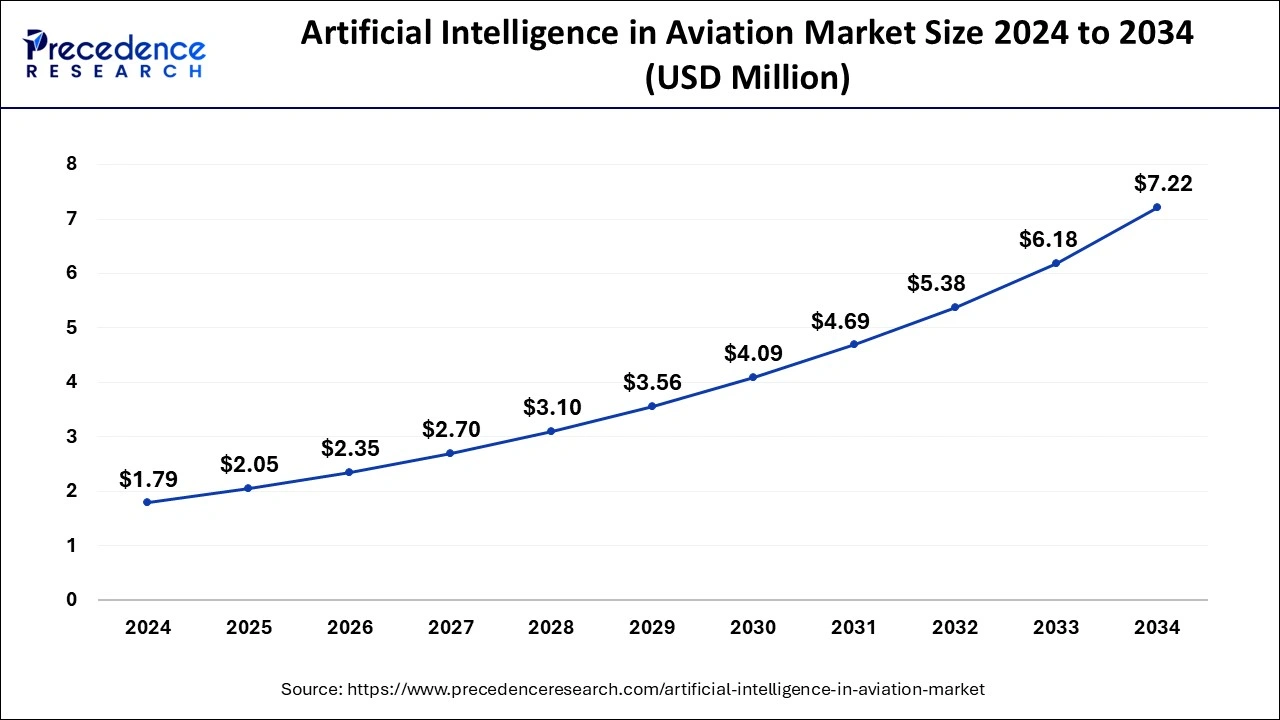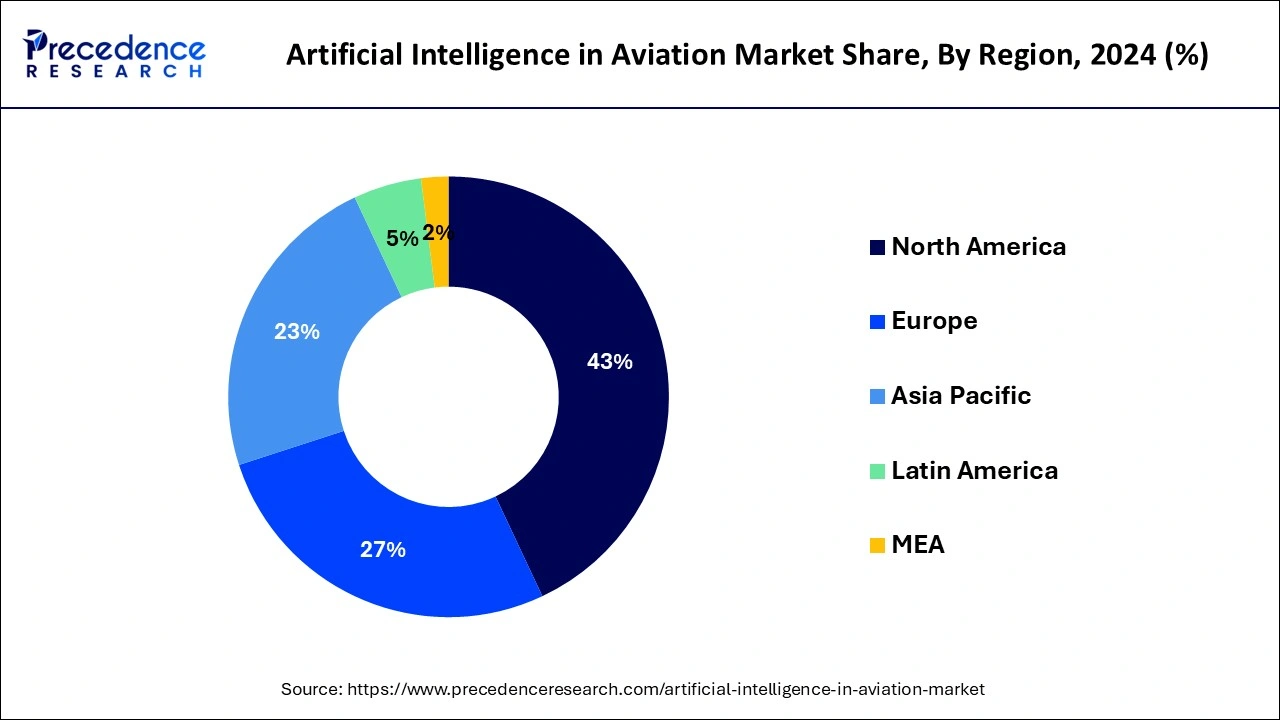November 2024
The global artificial intelligence in aviation market size is calculated at USD 5.96 million in 2025 and is forecasted to reach around USD 20.63 million by 2034, accelerating at a CAGR of 14.80% from 2025 to 2034. The North America artificial intelligence in aviation market size surpassed USD 2.23 million in 2024 and is expanding at a CAGR of 14.93% during the forecast period. The market sizing and forecasts are revenue-based (USD Billion/Million), with 2024 as the base year.
The global artificial intelligence in aviation market size was estimated at USD 5.19 million in 2024 and is anticipated to reach around USD 20.63 million by 2034, expanding at a CAGR of 14.80% from 2025 to 2034.

The U.S. artificial intelligence in aviation market size was evaluated at USD 1.79 million in 2024 and is predicted to be worth around USD 7.22 million by 2034, rising at a CAGR of 14.96% from 2025 to 2034.

North America dominated the global artificial intelligence in aviation market with the largest share of 43% in 2024. The presence of well-established air transport infrastructure in the region and the rising investments in the adoption of latest and advanced digital and novel technologies has led to the growth of the North America AI in aviation market. The huge demand for the air travel and rising number of air travelers in the region is expected to attract significant investments in the adoption of the AI technology at the airports and aircrafts. The globalization of businesses has led to the rising number of international flight travels in the US and Canada. North America is one of the early adopters of the AI based technologies in the aviation industry. The rising investments by the airline companies in the adopting the AI technologies to improve customer service, smoothen operations, and increase profitability is boosting the growth of the market in North America.

Asia Pacific is anticipated to be the most opportunistic market during the forecast period. Asia Pacific nations like China, India, Thailand, South Korea, Australia, and New Zealand are heavily investing in the develoip0ment of advanced airline infrastructure to boost tourism in the region. Asia Pacific is one of the most popular destinations across the globe. The rising tourism industry is fostering the development of advanced air connectivity, which is expected to significantly boost the growth of the Asia Pacific AI in aviation market.
The global Ai in aviation market is expected to witness a significant rise during the forecast period, owing to the rising usage of big data analytics in the aerospace industry. The rapidly increasing investments by the aerospace companies in towards the adoption of the cloud-based technologies and services is boosting the growth of the global AI in aviation market. The airlines industry and the airports are increasingly adopting the latest and novel technologies like artificial intelligence to improve services and smooth operations. The rising operational costs and rising need for improving the profitability is fostering the adoption of AI in the aviation industry. Airways has now become an important medium of transport across the globe and hence the rising focus on the improvement of the customer services is significantly boosting the demand for the AI in aviation industry. There has been a significant rise in the adoption of the AI based chat bots that facilitates the travelers in online ticket booking.
The adoption of the AI and machine learning technologies are expected to enhance the air traffic control and predictive maintenance activities in the near future. The adoption of AI for observation tasks such as time series analysis, natural language processing, and computer vision. The ongoing developments and rising investments on the research activities are expected to surge the number of applications of AI in the various complex operations of the aviation industry. EHang, a China-based company and Airbus are collectively engaged in developing AI-based navigation technology. EHang uses AI in its autonomous aircrafts and Airbus has completed its first taxi, take-off and landing using the vision based AI. Therefore, the rising focus on the adoption of the AI for performing different operations in the aviation industry is significantly boosting the growth of the global AI in aviation market.
| Report Coverage | Details |
| Market Size by 2034 | USD 20.63 Million |
| Market Size in 2025 | USD 5.96 Million |
| Growth Rate from 2025 to 2034 | CAGR of 14.80% |
| Largest Market | North America |
| Base Year | 2024 |
| Forecast Period | 2025 to 2034 |
| Segments Covered | Offering, Technology, Application, Geography |
| Regions Covered | North America, Europe, Asia-Pacific, Latin America, and Middle East & Africa |
Based on offering, the software segment dominated the global AI in aviation market in 2024. The rapid emergence and investments in the development of AI-based software for its application in airport operations, surveillance, and flight operations has led to the growth of the software segment exponentially. The AI systems includes software like application program interfaces such as speech, sensor data, language, vision, and machine learning algorithms that realizes the various applications of software in the aviation industry.
Services is expected to be the fastest-growing segment during the forecast period. The growth is attributed to the rising adoption of the services provided by the specialized technicians that can efficiently handle the AI systems. The lack of technical skills among the airline staffs regarding the AI technology is expected to boost the growth of the services segment in the global AI in aviation market during the forecast period.
The machine learning segment held the largest revenue share in the global AI in aviation market in 2024. The rising demand for the big data analytics and growing need for collecting data is significantly boosting the demand for the machine learning technology in the aviation industry across the globe. The enhanced capabilities of the machine learning technology to perform complex and impossible calculations has led to the dominance of the machine learning segment in the global AI in aviation market.
The natural language processing (NLP) is expected to be the most opportunistic segment during the forecast period. The NLP technology can conveniently scan the text data and convert it into documents like tickets, invoices, and agreement. It can use deep learning to encode words and phrases. Moreover, the NLP can identify the potential repeat defects of the aircrafts based on the Recurring Defects Management. Several other functions on NLP like revenue management, drone aircraft control system, ensure flight safety, customer interactions quantification, and feedback analysis are significantly boosting the adoption of the NLP in the aviation industry.
The virtual assistants segment dominated the global AI in aviation market in 2024. The virtual assistants powered by the AI technology helps in improving the efficiency and performance of the pilots by reducing or eliminating the recurring tasks such as reading wind forecasts, providing on request position information, and changing radio channels. Therefore, the demand for the virtual assistant is significantly high as it reduces the recurring work for the pilots. Moreover, the rising adoption of virtual assistants to improve customer service and providing answers to simple questions regarding the services or offerings and flight status is expected to further fuel the growth of this segment during the forecast period. The virtual assistants are adopted to serve the air travelers at the airport. For instance, the deployment of the virtual assistants in the security line helps the passengers with security instructions and various steps required in security check.
By Offering
By Technology
By Application
By Geography
For inquiries regarding discounts, bulk purchases, or customization requests, please contact us at sales@precedenceresearch.com
No cookie-cutter, only authentic analysis – take the 1st step to become a Precedence Research client
November 2024
February 2025
July 2024
March 2025